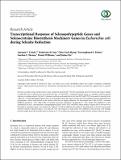Transcriptional Response of Selenopolypeptide Genes and Selenocysteine Biosynthesis Machinery Genes in Escherichia coli during Selenite Reduction
Abstract
Bacteria can reduce toxic selenite into less toxic, elemental selenium (Se0), but the mechanism on how bacterial cells reduce selenite at molecular level is still not clear. We used Escherichia coli strain K12, a common bacterial strain, as a model to study its growth response to sodium selenite (Na2SeO3) treatment and then used quantitative real-time PCR (qRT-PCR) to quantify transcript levels of three E. coli selenopolypeptide genes and a set of machinery genes for selenocysteine (SeCys) biosynthesis and incorporation into polypeptides, whose involvements in the selenite reduction are largely unknown. We determined that 5 mM Na2SeO3 treatment inhibited growth by ∼50% while 0.001 to 0.01 mM treatments stimulated cell growth by ∼30%. Under 50% inhibitory or 30% stimulatory Na2SeO3 concentration, selenopolypeptide genes (fdnG, fdoG, and fdhF) whose products require SeCys but not SeCys biosynthesis machinery genes were found to be induced ≥2-fold. In addition, one sulfur (S) metabolic gene iscS and two previously reported selenite-responsive genes sodA and gutS were also induced ≥2-fold under 50% inhibitory concentration. Our findings provide insight about the detoxification of selenite in E. coli via induction of these genes involved in the selenite reduction process.
Citation
Tetteh , A Y , Sun , K H , Hung , C-Y , Kittur , F S , Ibeanu , G C , Williams , D & Xie , J 2014 , ' Transcriptional Response of Selenopolypeptide Genes and Selenocysteine Biosynthesis Machinery Genes in Escherichia coli during Selenite Reduction ' , International Journal of Microbiology , vol. 2014 , 394835 . https://doi.org/10.1155/2014/394835
Publication
International Journal of Microbiology
Status
Peer reviewed
ISSN
1687-918XType
Journal article
Rights
Copyright © 2014 Tetteh et al. This is an open access article distributed under the Creative Commons Attribution License, which permits unrestricted use, distribution, and reproduction in any medium, provided the original work is properly cited.
Description
This work was supported by a United States Department of Agriculture-Cooperative State Research, Education, and Extension Service grant (no. 2009-35318-05032), a Biotechnology Research grant (no. 2007-BRG-1223) from the North Carolina Biotechnology Center, and a startup fund from the Golden LEAF Foundation to the Biomanufacturing Research Institute and Technology Enterprise (BRITE).Items in the St Andrews Research Repository are protected by copyright, with all rights reserved, unless otherwise indicated.

